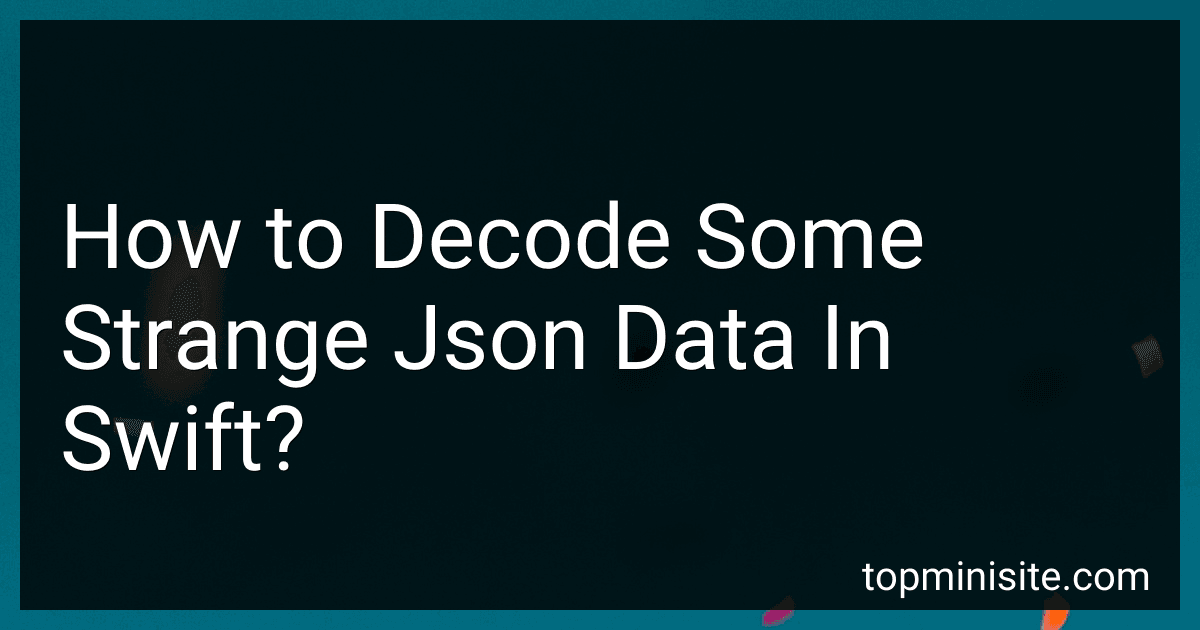To decode some strange JSON data in Swift, you can use the Codable protocol along with the JSONDecoder class provided by the Foundation framework. First, define a struct or a class that conforms to the Codable protocol and represents the structure of the JSON data you are trying to decode. Then, create an instance of JSONDecoder and use its decode method to decode the JSON data into your custom data type. If the JSON data contains nested structures or arrays, make sure to define corresponding nested structs or classes in your data model. If the JSON data is not in a standard format or contains unexpected keys, you may need to implement custom decoding logic using the Decodable protocol.
How to decode JSON objects with different structures in Swift?
In Swift, you can decode JSON objects with different structures using the Codable protocol. The Codable protocol allows you to easily encode and decode JSON data into Swift data types.
Here's an example of how you can decode JSON objects with different structures in Swift:
import Foundation
// Define the structure of the JSON data using Codable protocol struct ObjectA: Codable { let propertyA: String }
struct ObjectB: Codable { let propertyB: Int let propertyC: String? }
// Define a function to decode JSON objects func decodeJSON(jsonData: Data) { do { let decoder = JSONDecoder()
// Try to decode the JSON data as ObjectA
if let objectA = try? decoder.decode(ObjectA.self, from: jsonData) {
print(objectA)
}
// Try to decode the JSON data as ObjectB
if let objectB = try? decoder.decode(ObjectB.self, from: jsonData) {
print(objectB)
}
} catch {
print("Error decoding JSON data: \\(error)")
}
}
// Example JSON data let jsonDataA = """ { "propertyA": "ValueA" } """.data(using: .utf8)!
let jsonDataB = """ { "propertyB": 123, "propertyC": "ValueC" } """.data(using: .utf8)!
// Decode the JSON data decodeJSON(jsonData: jsonDataA) decodeJSON(jsonData: jsonDataB)
In this example, we have two different structures for the JSON objects (ObjectA and ObjectB) and we use the JSONDecoder class to decode the JSON data into these structures. The JSONDecoder class automatically handles parsing the JSON data and mapping it to the corresponding Swift data types defined in the Codable structs.
By checking for errors and using optional binding, we can try to decode the JSON data as different structures and handle any decoding errors that may occur.
What is the difference between JSONSerialization and Codable in Swift?
JSONSerialization is a class in Swift that provides methods for converting JSON data to Foundation objects such as arrays and dictionaries, and vice versa. It is often used for manual JSON parsing and serialization.
Codable is a protocol in Swift that defines a type that can be encoded to and decoded from an external representation, such as JSON. Types that conform to the Codable protocol can be easily converted to and from JSON using the JSONEncoder and JSONDecoder classes.
The main difference between JSONSerialization and Codable is that JSONSerialization is a more low-level API that requires manual parsing and serialization of JSON data, while Codable provides a higher-level, more streamlined approach to converting Swift objects to and from JSON. Codable also provides additional features such as handling nested objects and arrays, and allowing for customization of the encoding and decoding process.
What is JSON parsing in Swift?
JSON parsing in Swift refers to the process of converting JSON (JavaScript Object Notation) data into native Swift data types such as dictionaries, arrays, strings, and numbers. This allows developers to easily work with JSON data in their Swift applications by extracting and manipulating the data in a structured way. JSON parsing in Swift is commonly used when working with APIs that return data in JSON format, such as fetching data from a web service. There are various methods and libraries available in Swift to parse JSON data, such as using the built-in JSONSerialization class or third-party libraries like SwiftyJSON.
